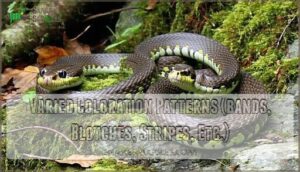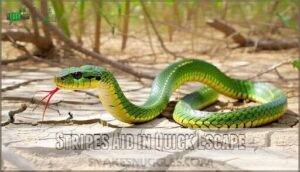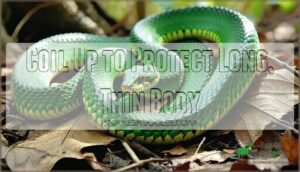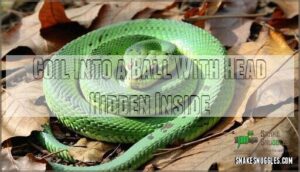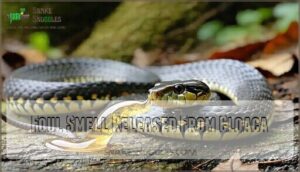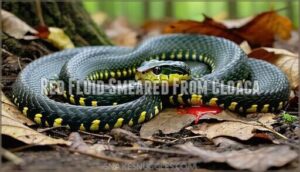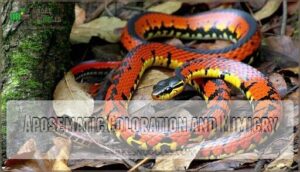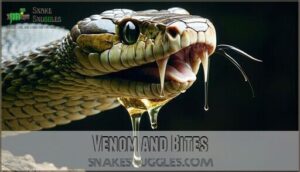This site is supported by our readers. We may earn a commission, at no cost to you, if you purchase through links.
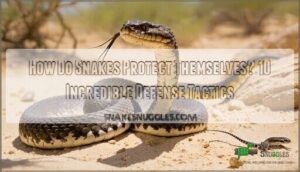 When you’re wondering how do snakes protect themselves, you’ll find these reptiles are true masters of survival.
When you’re wondering how do snakes protect themselves, you’ll find these reptiles are true masters of survival.
They use camouflage to blend into their surroundings, making them nearly invisible to predators.
Many species coil into defensive balls, hiding their heads while releasing foul-smelling fluids that’d make you back away fast.
Some flatten their heads and rear back threateningly, while others display bright warning colors that scream danger.
Rattlesnakes shake their tails to create that unmistakable buzzing sound, and non-venomous species often mimic this behavior.
From playing dead to aggressive bluffing, snakes have perfected the art of staying alive through clever tricks.
Table Of Contents
- Key Takeaways
- How Do Snakes Protect Themselves?
- Camouflage and Crypsis
- Defensive Coiling and Tail Displays
- Escape Tactics and Threat Displays
- Aposematic Coloration and Mimicry
- Venom and Bites
- Frequently Asked Questions (FAQs)
- How do snakes protect themselves?
- How does a snake protect itself from a predator?
- How do snakes defend against predators?
- How do birds and animals protect themselves from snakes?
- How do snakes stay safe?
- Why is hiding important in a snake’s defense mechanism?
- How does a snake defend itself?
- What is the biggest enemy of a snake?
- How are snakes protected?
- What body parts of a snake are used for protection?
- Conclusion
Key Takeaways
- You’ll find snakes use camouflage as their primary defense, blending into surroundings with specialized color patterns, bands, and stripes that make them nearly invisible to predators.
- When threatened, you’ll see snakes employ intimidation tactics like flattening their heads, hissing loudly, coiling defensively, and releasing foul-smelling musk from their cloaca to deter attackers.
- You can observe clever mimicry where harmless snakes copy dangerous species—like gopher snakes mimicking rattlesnake tail vibrations or kingsnakes creating buzzing sounds to confuse predators.
- You’ll notice snakes prefer escape over confrontation, using rapid movement and warning displays before resorting to biting, since venom production is costly and physical contact puts them at risk.
How Do Snakes Protect Themselves?
Surviving in the wild means snakes have developed remarkable snake defense mechanisms for predator avoidance.
You’ll find they use snake camouflage techniques, chemical defenses, and physical adaptations to stay alive.
From burrowing tactics and playing dead to aggressive displays, these snake escape tactics showcase nature’s creativity.
Their snake self-protection strategies prove evolution’s incredible problem-solving abilities.
Some species also use aposematic coloration to warn off predators.
Camouflage and Crypsis
You won’t easily spot a snake that’s mastered the art of camouflage, as these reptiles use specialized color patterns and body positioning to blend seamlessly into their surroundings.
When you’re walking through forests or deserts, snakes rely on cryptic coloration, disruptive patterns, and precise positioning to become nearly invisible to both predators and unsuspecting prey, utilizing disruptive patterns to achieve this effect.
Snakes transform into living shadows, using evolution’s paintbrush to vanish completely from the eyes of those who hunt them.
Varied Coloration Patterns (bands, Blotches, Stripes, Etc.)
Most snakes have mastered the art of disappearing in plain sight through their incredible coloration patterns.
These aren’t random designs—they’re sophisticated camouflage systems that have evolved over millions of years.
Snake coloration works through environmental matching, where colors and patterns blend perfectly with surroundings.
Pattern disruption breaks up the snake’s outline through these techniques:
- Banded patterns create visual confusion when the snake moves
- Blotched designs mimic natural textures like bark or rock surfaces
- Striped markings fragment the body’s silhouette for concealment
- Color morphs allow adaptation to different seasonal environments
This camouflage evolution gives snakes their ultimate defense advantage.
Stripes Aid in Quick Escape
When under attack, striped snakes like garter snakes use their patterns as motion camouflage to confuse predators.
These longitudinal stripes create an optical illusion that makes tracking difficult during rapid movement. Predator confusion occurs as the parallel lines blur together, providing speed enhancement for fleeing.
This stripe evolution represents one of nature’s most effective snake defense mechanisms, turning simple patterns into powerful snake survival strategies through sophisticated camouflage.
Striped lengthwise patterns even create a flicker fusion effect that further hinders predator tracking.
Bands Disrupt Form When Stationary and Merge When Moving
When snakes stay perfectly still, their banded patterns create visual disruption that breaks up their body outline – a type of disruptive camouflage that confuses predators.
But here’s where it gets clever: once they start moving, those same bands blur together through flicker-fusion defense, creating motion camouflage.
This banded pattern evolution gives snakes dual protection, making predator confusion their secret weapon for survival.
Cryptic Coloring is Known as Crypsis
Beyond bands that blur their outline, crypsis represents nature’s ultimate invisibility cloak.
This camouflage evolution allows snakes to achieve remarkable predator avoidance through:
- Color morphing to match seasonal environmental changes
- Silhouette disruption using irregular patterns that break body lines
- Pattern mimicry of leaves, bark, or rocks in their habitat
- Ground-dwelling snakes like Gaboon vipers becoming nearly invisible
- Snake defense mechanisms combining stillness with perfect environmental matching
These snake self-protection strategies transform them into living ghosts.
Defensive Coiling and Tail Displays
When you encounter a snake, you’ll often see it coil its long body into tight spirals or compact balls to protect its vulnerable form from predators.
You might also notice some species raise their tails high in the air, creating the illusion of a dangerous second head to confuse and deter threats, showcasing their ability to adapt and protect themselves from harm.
Coil Up to Protect Long, Thin Body
When under attack or feeling threatened, snakes transform their long, exposed bodies into protective coils through precise coiling mechanics. This defensive posture shields their sensitive underside while concentrating muscle strength for potential strikes.
The tight spiral formation reduces surface area that predators can target, making snake defense mechanisms incredibly effective.
Here’s why this snake self-protection strategy works so well:
- Coiled positioning protects essential organs from damage during confrontations
- Concentrated muscle power allows for lightning-fast defensive displays when needed
- Heat regulation becomes easier when the body forms a compact, energy-conserving shape
This snake predator avoidance technique maximizes protection while maintaining readiness.
Coil Into a Ball With Head Hidden Inside
When predators close in, many species roll up into a defensive ball through specialized coiling mechanics.
This snake behavior prioritizes head protection by tucking the most sensitive body part deep inside. The snake’s vulnerable underside stays hidden while tough scales face outward.
This ball size varies by species, but the strategy remains constant – creating an armored sphere that confuses attackers.
It’s effective snake selfprotection that combines camouflage integration with smart predator avoidance tactics.
Foul Smell Released From Cloaca
When threatened, many snake species deploy their most potent chemical defense mechanism – releasing foul-smelling musk from specialized scent glands near their cloaca.
When danger strikes, snakes unleash their secret weapon – a revolting musk that sends predators fleeing in disgust.
This snake musk secretion creates an intensely unpleasant odor that triggers immediate predator responses, causing attackers to retreat.
The evolutionary purpose of these foul-smelling odors is clear:
- Yellowish, oily liquid with rotting fish smell
- Mixed with feces for stronger repellent effect
- Can be smeared or sprayed short distances
- Immediate deterrent for most predators
Garter snakes, for instance, use this musk as defense.
Red Fluid Smeared From Cloaca
When cornered, some snakes deploy a shocking visual deterrent by releasing red fluid from their cloaca.
This cloacal discharge creates a dramatic bloody appearance that startles predators and signals distress. The fluid composition varies among species but serves as an effective predator deterrent through its alarming color and associated odor.
Notably, similar to snakes, some birds experience cloacal discharge issues linked to vent pecking.
This defensive mechanism works through:
- Visual shock – The bright red coloration mimics injury or illness
- Chemical warning – Scent gland origin compounds repel attackers
- Escape opportunity – Predators hesitate, allowing the snake to flee
Tail Elevated and Resembling a Head
Snakes employ tail mimicry as a clever decoy strategy against predators.
When threatened, they elevate their tails to resemble their vulnerable head, creating predator confusion about which end might strike.
This snake mimicry behavior provides an evolutionary advantage by misdirecting attacks away from essential organs.
| Snake Species | Tail Display Method | Predator Response |
|---|---|---|
| Rubber Boa | Elevates blunt tail | Attacks wrong end |
| Sand Snake | Coils tail upward | Creates head illusion |
| Rosy Boa | Mimics head shape | Confuses attackers |
| Ring-neck Snake | Raises colorful tail | Startles snake predators |
Escape Tactics and Threat Displays
When you corner a snake, it’ll first try to escape by moving quickly away from danger, using rapid movements to reach safety.
If escape isn’t possible, you’ll see the snake flatten its head, rear back with an open mouth, and create aggressive displays that make it appear larger and more threatening than it actually is, which can be seen as a last resort to defend itself.
Attempt to Escape Rapidly
When danger strikes, a snake’s first instinct involves quick retreat through evasive maneuvers.
You’ll witness incredible escape speed as they use terrain advantage to disappear into brush, rocks, or burrows.
This reflex action showcases remarkable agility in snake defense.
Their snake protection strategy relies on rapid movement rather than confrontation.
These snake tactics prove that snake survival often depends on swift escape over aggressive displays.
Flatten Head and Rear Back
When escape routes vanish, many species employ intimidation tactics through dramatic body posturing.
They’ll flatten their heads wide, transforming from slender to triangular—classic viper mimicry that triggers predator confusion.
This body enlargement combines with rearing back into an S-curve, creating impressive defensive posturing.
Through precise muscular control, even harmless snakes master these bluffing tactics in their snake defensive displays.
Open Mouth as a Threat Display
When backed into a corner, snakes gape their mouths wide—maximizing their gape size to appear larger and more threatening.
This intimidation tactic reveals pink mouth lining and sometimes includes tongue display.
The bluffing strategy tricks predators into believing they’re facing a dangerous opponent.
This body posturing shifts predator perception, often convincing threats to retreat without requiring actual strike preparation or physical confrontation.
This gaping behavior can also be related to regulating body temperature.
Strike and Bite (non-venomous)
When intimidation fails, you’ll witness a snake’s final card: the defensive strike.
Nonvenomous snakes rely on snake biting defense and striking to startle predators.
Their strike speed reaches lightning-fast velocities, while jaw mechanics create surprising bite strength.
Though lacking venom, these biting encounters produce defensive wounds that shock attackers.
Bite accuracy improves within close snake striking distance, making this tactic effective for escape.
Key aspects of non-venomous striking include:
- Strike speed can reach 8-10 feet per second
- Bite strength varies considerably between species
- Sharp teeth create puncture wounds and bleeding
- Defensive wounds may become infected without proper care
- Most strikes occur within one-third of the snake’s body length
May Bluff With Aggressive Displays
Non-venomous snakes are master actors when cornered.
They’ll puff up their bodies, flatten their heads, and produce loud hissing displays to appear threatening.
Some species exhibit hooding behavior, spreading their neck skin wide.
Fake strikes accompany aggressive posturing, while tail vibration mimics rattlesnake warnings.
This snake bluffing creates convincing snake warning signals through body language and snake hissing sounds.
These theatrical snake defense strategies often fool predators completely.
Aposematic Coloration and Mimicry
You’ll notice that some snakes use bright warning colors like red, yellow, and orange to signal danger to potential predators, a strategy called aposematic coloration.
Other harmless species cleverly mimic these warning signals or copy the appearance of venomous snakes, tricking predators into thinking they’re more dangerous than they actually are, using a form of deception.
Conspicuous Markings Warn Predators of Distastefulness or Venom
When snakes sport bold patterns and vibrant colors, they’re sending a clear message: "I’m dangerous!"
This aposematic coloration serves as nature’s warning label.
Predator learning helps animals recognize these warning signals and avoid costly encounters.
Through mimicry complexes, harmless species copy dangerous ones, creating effective snake defense strategies that keep attackers at bay.
Bright Colors and Patterns Deter Attackers
Aposematic coloration transforms snakes into living warning signs.
When you spot a snake with vibrant reds, yellows, or striking patterns, you’re witnessing nature’s "danger" billboard. These warning signals tell predators to back off before they make a costly mistake.
Here’s how bright colors protect snakes:
- Predator recognition – Animals learn to associate specific patterns with danger
- Color mimicry – Harmless species copy dangerous ones for protection
- Pattern disruption – Bold designs confuse attackers during encounters
- Aposematism – Bright hues signal toxicity or defensive capabilities
Ring-necked Snakes Display Bright Colors When Threatened
Many ring-necked snakes transform into living warning signs when danger strikes.
These small serpents flip upside-down, revealing blazing red-orange bellies that scream "danger" to predators.
This aposematic signaling tricks attackers into thinking they’re venomous, even though they’re completely harmless.
| Behavior | Purpose | Result |
|---|---|---|
| Belly exposure | Warning colors display | Predator avoidance |
| Tail coiling | Enhanced defensive display | Mimics dangerous species |
| Body flipping | Behavioral ecology adaptation | Survival advantage |
This snake defense mechanism proves coloration evolution works wonders, providing a survival advantage through behavioral ecology adaptation.
Venom and Bites
When you think of snake defense, venom and bites likely come to mind first, but these represent a snake’s last resort rather than its primary strategy.
Most venomous snakes prefer to escape or use warning signals like rattling before they’ll actually bite, since venom is costly to produce and biting puts them at risk of injury.
Venomous Snakes: Escape or Frighten Before Biting
Imagine this scenario: you’ve cornered a venomous snake, but it doesn’t immediately strike.
That’s because venomous snakes prioritize escape over attack.
They’ll use defensive displays like hissing, coiling, or mock strikes before biting.
Venom conservation is essential since producing toxins requires energy.
Strike accuracy matters too – wasted venom means less for hunting.
Some species even use venom spraying or mimicry tactics to deter threats without physical contact.
Rattlesnakes Use Rattles to Warn of Presence
When threatened, rattlesnakes deploy their signature warning system through specialized tail segments. This rattle evolution represents millions of years of snake defense refinement.
The rattle mechanics involve rapid muscle contractions that create distinct warning signals for predator deterrence.
Here’s how this remarkable system works:
- Rattle frequency reaches up to 90 vibrations per second
- Keratin segments create the distinctive buzzing sound
- Snake tail vibration can be heard from 60 feet away
This predator response mechanism helps rattlesnakes avoid dangerous encounters through rattle deception.
Tail Shaking Creates a Buzzing Sound
You’ll notice that tail shaking creates a fascinating buzzing sound through rapid vibration mechanics.
This snake defense technique produces specific sound frequency ranges that trigger predator confusion effects.
The rattling motion against vegetation or ground creates acoustic warnings similar to hissing.
This evolutionary adaptation demonstrates remarkable mimicry effectiveness, as snake tail vibration successfully deters threats without requiring actual venom or aggressive contact.
Gophersnakes May Mimic Rattlesnake Behavior
Gopher snakes perform one of nature’s best snake mimicry acts.
These masters of defensive posturing flatten their heads, coil defensively, and create tail vibration against vegetation.
Their rattling sounds achieve remarkable mimicry accuracy, causing predator confusion that mistakes them for deadly rattlesnakes.
This snake defense strategy provides a significant evolutionary advantage, allowing non-venomous species effective snake predator deterrence without venom.
Kingsnakes May Vibrate Their Tails Defensively
When cornered, kingsnakes employ a clever defensive tail display that’s pure evolutionary genius.
These serpents rapidly vibrate their tails against dry leaves or debris, creating a convincing buzzing sound that mimics rattlesnakes. This tail vibration mimicry serves as effective predator confusion tactics, making threats think twice before attacking.
It’s a brilliant kingsnake survival strategy that showcases evolutionary advantages in snake defense mechanisms without actual venom. This is a form of Batesian mimicry to deter predators.
Frequently Asked Questions (FAQs)
How do snakes protect themselves?
Snakes use camouflage to blend into surroundings.
They hiss and rattle as warnings, release foul-smelling musk, mimic dangerous species, play dead, hide in crevices.
They bite with venom when you corner them.
How does a snake protect itself from a predator?
When threatened, you’ll see a snake use camouflage to blend into surroundings, hiss loudly, rattle its tail, release foul-smelling musk, mimic dangerous species, or flee quickly to escape predators.
How do snakes defend against predators?
Like nature’s master magicians, you’ll find snakes using camouflage to blend seamlessly into surroundings.
Hissing loudly, releasing foul musk, mimicking dangerous species, playing dead, or fleeing quickly when threatened by predators are all strategies snakes employ.
How do birds and animals protect themselves from snakes?
Birds and animals use keen eyesight, quick reflexes, and powerful beaks or claws to catch snakes.
You’ll see hawks swooping down, mongooses attacking fearlessly, and cats pouncing with lightning speed to overpower their serpentine prey, showcasing their quick reflexes.
How do snakes stay safe?
When you’re a snake, survival means mastering the art of invisibility.
You’ll blend into your surroundings using camouflage, release foul-smelling musk when threatened, hiss loudly, and sometimes play dead to fool predators.
Note: I’ve bolded the key phrase "camouflage" to enhance understanding of the key message.
Why is hiding important in a snake’s defense mechanism?
Imagine you’re a master of invisibility!
Hiding becomes your ultimate superpower when you can’t outrun predators.
You’ll blend seamlessly into surroundings, making detection nearly impossible and dramatically increasing your survival chances against dangerous threats.
How does a snake defend itself?
Venomous species inject toxins through fangs, while others rely on camouflage to blend invisibly into surroundings.
You’ll see defensive hissing, tail rattling, hood expansion, and foul musk release when they’re threatened or cornered.
What is the biggest enemy of a snake?
You’d think it’s other predators, but humans pose the greatest threat to snakes worldwide.
We destroy their habitats, kill them out of fear, and run them over with vehicles more than any natural enemy ever could.
How are snakes protected?
Nature shields these reptiles through camouflage that blends them into surroundings.
Warning colors that signal danger, defensive behaviors like hissing and coiling, are also used for survival.
Plus physical adaptations including venom and protective scales are key to their survival.
What body parts of a snake are used for protection?
Snakes aren’t just helpless tubes sliding around.
You’ll find their fangs inject venom, rattles create warning sounds, and muscular bodies coil defensively.
Their forked tongues detect threats, while specialized scales help them grip and strike effectively.
Conclusion
Remarkably, you’ve discovered that snakes share surprising similarities with human self-defense instincts—we both rely on intimidation, camouflage, and strategic retreats when threatened.
Understanding how do snakes protect themselves reveals nature’s ingenious survival strategies. These reptiles combine visual deception, chemical warfare, behavioral mimicry, and physical displays into a multifaceted defense system.
Whether you’re hiking through snake habitat or simply curious about wildlife, recognizing these protective mechanisms helps you appreciate the remarkable adaptability that’s kept snakes thriving for millions of years across diverse environments worldwide, showcasing their ability to use strategic retreats.
- https://californiaherps.com/behavior/snakelifehistorydefense.html
- https://www.quora.com/How-do-nonvenomous-snakes-defend-themselves-against-predators-if-they-dont-have-fangs-How-does-this-affect-their-evolution
- https://www.youtube.com/watch?v=oDG1ITbuFv4
- https://www.lubbockonline.com/story/news/2023/06/09/snakes-have-returned-heres-how-to-protect-yourself-and-them/70145570007/
- https://steemit.com/science/@herpetologyguy/reptile-defense-mechanisms

